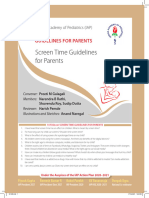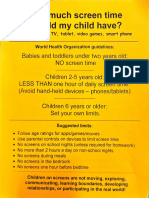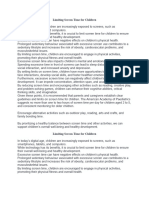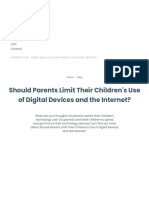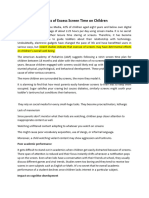0% found this document useful (0 votes)
15 views3 pagesMethods & Recomm 2
The American Academy of Pediatrics recommends screen time guidelines based on age, advising no screen time for infants, one hour for preschoolers, and one to two hours for school-aged children, while encouraging open discussions for teenagers. Families should establish a media plan, promote physical activity, and lead by example to foster healthy screen habits. Balanced screen time can enhance children's education, creativity, and family relationships when managed appropriately.
Uploaded by
karlalorenam08Copyright
© © All Rights Reserved
We take content rights seriously. If you suspect this is your content, claim it here.
Available Formats
Download as DOCX, PDF, TXT or read online on Scribd
0% found this document useful (0 votes)
15 views3 pagesMethods & Recomm 2
The American Academy of Pediatrics recommends screen time guidelines based on age, advising no screen time for infants, one hour for preschoolers, and one to two hours for school-aged children, while encouraging open discussions for teenagers. Families should establish a media plan, promote physical activity, and lead by example to foster healthy screen habits. Balanced screen time can enhance children's education, creativity, and family relationships when managed appropriately.
Uploaded by
karlalorenam08Copyright
© © All Rights Reserved
We take content rights seriously. If you suspect this is your content, claim it here.
Available Formats
Download as DOCX, PDF, TXT or read online on Scribd
/ 3



